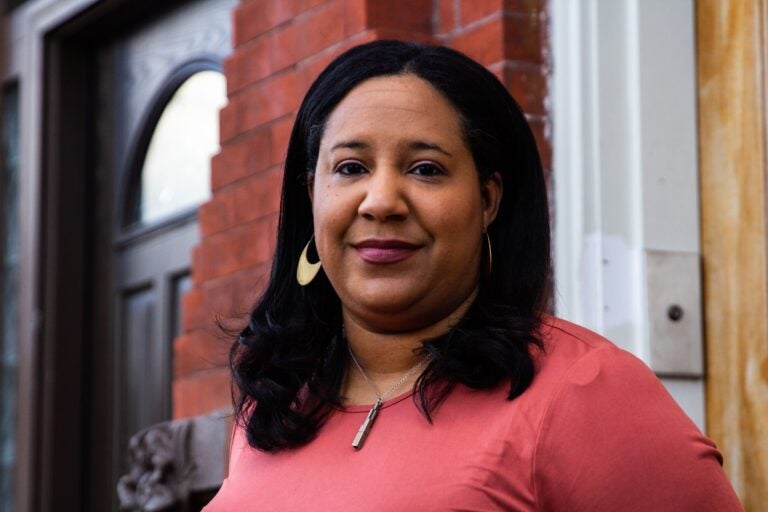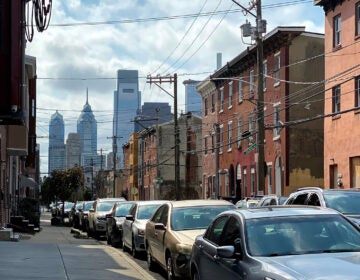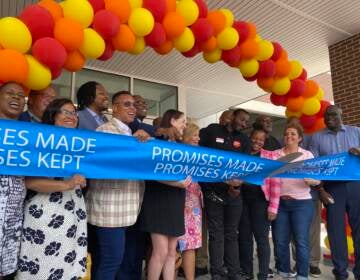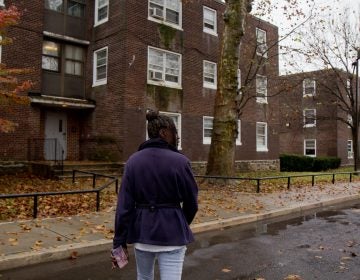Tya Winn takes the helm of Community Design Collaborative with racial equity a priority
34-year-old Tya Winn enters her new role as director of the Community Design Collaborative with a focus on community development and affordable housing.

Tya Winn is the new executive director of the Community Design Collaborative. (Kimberly Paynter/WHYY)
Being unsure is not one of Tya Winn’s problems. She said she had most of her life goals set by kindergarten.
“I wanted to see Big Bird, I wanted to be Rocky, and I wanted to be an architect,” said the 34-year-old. Her family was the most supportive of the last one.
Some of her earliest memories growing up in Chicago’s South Shore neighborhood include playing make-believe with other kids — and designing the imaginary towns and cities where she and friends wanted to be. One elaborate fantasy had her and classmates living in a dream house that included a McDonald’s, an arcade, and separate rooms for every child.
“I was already in that space just out of the gate,” she said, noting that she would frequently get in trouble with her teachers for talking in class.
That memory likely comes as no surprise for those in Philadelphia’s community development world, where Winn has made a name for herself as an architect, project planner organizer, and now — the executive director of the Community Design Collaborative. She will be the third Executive Director of the Community Design Collaborative, the second full time Executive Directorhistory and the first Black leader. Winn succeeds former longtime executive director Beth Miller and interim ED Jenn Richards.
Winn joins the Philadelphia-based architectural nonprofit best known for providing pro-bono public interest design services after three years at Habitat for Humanity Philadelphia, where she served as the director of project planning and design. Before Habitat, Winn worked for the Philadelphia Housing Authority and spent several years at Logan CDC in North Philadelphia managing programs and working with their real estate development portfolio. She teaches real estate development at Thomas Jefferson University and community development at Temple University. She also serves on the board of directors for Families Forward — a family shelter combating homelessness.
While Winn has dedicated much of her career to date to solving the city’s affordable housing challenges, the move to an organization focused on architecture and planning reflects a return to her roots in more ways than one.
Winn serves on the board of the National Organization of Minority Architects, PhilaNOMA, the organization’s local chapter, and is an adviser for the Hip Hop Architecture Camp — all part of her work to diversify architecture and bring other Black women into a field where they make up less than 1%.
She’s a core organizer for both Design As Protest, an organization that aims to reverse urban planning that negatively impacted Black communities, and Dark Matter University, which aim to reimagine design education and practice through an anti-racist lens.
Winn’s reach and resume reflect aspirations that have shifted since she was a child but always stayed true to certain values.
The millennial described her upbringing as a “restorative social justice household.” Her mother worked at one of the largest nonprofits in Chicago, so Winn has never been a stranger to that world.
By the time she was a late teen, she knew she wanted to prioritize affordable housing and community development. Growing up, she witnessed a lot of public housing being torn down in Chicago in the late ’80s and early ’90s.
“I’ve always talked about trying to find a better solution for those communities that kept and centered those communities’ needs,” Winn said. “That’s why I wanted to be an architect.”
The Chicagoan went to Syracuse University to study architecture but when she graduated during the Great Recession with a BARCH, she didn’t see a space that reflected her ambitions.
“I knew it was something I was interested in, but there were not many examples of practitioners that were in that space,” she said.
It wasn’t until she decided to pursue grad school to get her masters of architecture with a specialization in urban design at the Stuart Weitzman School of Design at the University of Pennsylvania that her career visions began to take shape. She was in a city where organizations like the one she will now helm have practiced public interest design for decades.
After a few temporary jobs, Winn eventually landed in North Philadelphia at Logan CDC, a community development corporation where she could use her design skills to bring some of the design amenities seen in more affluent areas to a neighborhood long underserved.
The success that made her believe
Winn’s first triumph that made her think she could use design to change a community happened soon after she began working at Logan CDC in 2012.
Parklets, parks created in former parallel parking spaces, were popping up in University City. Logan CDC and the Mayor’s Office of Transportation and Utilities were behind the project. The parklets were all in traditional commercial corridors outside of restaurants, and they were functioning mainly as additional outdoor dining.
Winn reimagined the concept for the Logan Branch of The Free Library of Philadelphia. She wanted to create a space for people to read, work or just enjoy a public space. It was not a typical project at the time, but she convinced her boss at the CDC to let her do it.
“I was like, ‘Well, I’ll do the whole brand,’” she said. “I don’t need your grant writer. I’ll do everything myself if you just let me do this.”
And that’s exactly what she did. She got the grant, spearheaded community engagement, and secured the city permit. She managed to recruit the local NOMA chapter for primarily design help and volunteers to get signatures and other manual labor.
What inspired her to apply was that she was also hosting community meetings and a desire that kept coming up was a place to meet and congregate.
“There weren’t a lot of comfortable places to be together,” Winn said. “There weren’t any safe places together. They had very limited spaces where they could sit outside.”
The entire process took about eight months.
“It energized me,” Winn said. “I realized that all the things I thought were important were still important and rededicated me to the path I was on.”
When asked what it’s like to work in a white-dominated industry, she sighed. Winn has been in traditionally white spaces her entire life, she said.
She is not licensed as an architect yet. She won’t be able to do that for about another year because of the requirements. However, she is well on the way with five of the seven tests done, 5,000 hours of practical work complete, and two professional certifications as well as her Penn masters degree.
When Winn does get that licensure, she’ll join a tiny group of architects that share her identity as a Black woman.
In Philadelphia, there are only 32 Black architects. Of that, only nine are Black women, according to the Directory of African American Architects. On a national scale, Black women are among the least represented groups in the field, making up 0.4 percent.
“I think the biggest obstacles are being comfortable with my own voice,” she said of her reality as a Black woman in a field dominated by white men. “You know you’re perceived a certain way when you do speak up, and so I think it’s an internal struggle more than anything. How do you fight that sneaking suspicion of imposter syndrome every day?”
Winn admitted she questions if she’s a token in rooms often. Over the years in her career, she said she has learned to live with that question.
“Am I checking a box? And in some instances, I’ve always had to come to accept that might be true. But in them checking this box, I still have a seat at the table. And so what’s my responsibility while I’m here?”
Why community development matters
Winn grew up fairly privileged as upper-middle class in a city that wrestles with a massive poverty problem like Philadelphia.
“I was still often in spaces and in neighborhoods confronted with a lot of people that looked like me but wasn’t as lucky as me,” she said of her upbringing in Chicago.
She remembers her South Shore neighborhood, just six miles south of Chicago’s ritzy Loop area, as both predominantly Black and economically diverse in her younger years. As she grew older, that shifted. By the time she was 13, she wasn’t allowed to be outside anymore because of increasing crime and blight. If she left, it was for a car ride to go to another neighborhood. Instead, she ended up spending most of her time in whiter neighborhoods.
“When you’re a kid, you pick up on that pretty quickly,” Winn said. “I never thought it was fair because I had friends and they would tell me how lucky I was. I didn’t understand why those other kids couldn’t access those spaces.”
From a young age, she recognized that “the big equalizer was the built environment.”
Now she lives on Francisville and Fairmount’s border, an area where property values are rising quickly and demographics shifting as rents and home prices increase. She sees her neighborhood changing — there are new buildings and new amenities like bike shops and coffee shops. But those places are hiring within the community, she said.
“It has brought existing residents along with embracing the new,” Winn noted. “There’s not many instances of that happening in the city.”
She also thinks the Community Design Collaborative can play a part in training designers to be more attuned and responsive to racial and economic equity issues.
It’s that “idea of equity” that drew her to her new position at the CDC, she said.
“I see the organization functioning more as a catalyst,” she said.
In Philadelphia, she said the work is easier because people are receptive to her work.
“The community members have a value and that’s the past,” she said. “They have a rich knowledge and history in their own communities. I think many times people sell them short but they understand exactly what happened.”
Winn sees herself as just bringing expertise to ideas that communities and organizations already have. Because the collaborative doesn’t build anything itself, Winn said she takes pride that her nonprofit provided services that allow other organizations to continue doing equity work.
“To me, that’s really important,” she said. “It’s the support of the organizations that are out here fighting to make a change and systemic change to these neighborhoods.”
One of the collaborative’s projects that she’s most excited about is Design A.I.D., which is helping restaurants design outdoor dining and helping schools and homeless shelters create safer ways to socially distance. It’s been ongoing throughout the pandemic.
She also thinks the collaborative can play a part in training designers to be more attuned and responsive to racial and economic equity issues.
In her eyes, an example is for designers to approach Black neighborhoods and figure out ways to support their ability to stay and not get displaced from the neighborhood. Or creating spaces that encourage more social integration.
“I think it’s easy,” she said. “We have a rich network of centers, institutions, and schools. It was always possible. It just wasn’t anybody’s agenda.”

Subscribe to PlanPhilly
WHYY is your source for fact-based, in-depth journalism and information. As a nonprofit organization, we rely on financial support from readers like you. Please give today.








